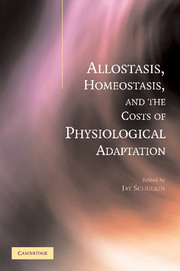Book contents
- Frontmatter
- Dedication
- Contents
- Preface
- Contributors
- Introduction
- 1 Principles of Allostasis: Optimal Design, Predictive Regulation, Pathophysiology, and Rational Therapeutics
- 2 Protective and Damaging Effects of the Mediators of Stress and Adaptation: Allostasis and Allostatic Load
- 3 Merging of the Homeostat Theory with the Concept of Allostatic Load
- 4 Operationalizing Allostatic Load
- 5 Drug Addiction and Allostasis
- 6 Adaptive Fear, Allostasis, and the Pathology of Anxiety and Depression
- 7 A Chronobiological Perspective on Allostasis and Its Application to Shift Work
- 8 Allostatic Load and Life Cycles: Implications for Neuroendocrine Control Mechanisms
- Commentary: Viability as Opposed to Stability: An Evolutionary Perspective on Physiological Regulation
- Index
Preface
Published online by Cambridge University Press: 05 February 2015
- Frontmatter
- Dedication
- Contents
- Preface
- Contributors
- Introduction
- 1 Principles of Allostasis: Optimal Design, Predictive Regulation, Pathophysiology, and Rational Therapeutics
- 2 Protective and Damaging Effects of the Mediators of Stress and Adaptation: Allostasis and Allostatic Load
- 3 Merging of the Homeostat Theory with the Concept of Allostatic Load
- 4 Operationalizing Allostatic Load
- 5 Drug Addiction and Allostasis
- 6 Adaptive Fear, Allostasis, and the Pathology of Anxiety and Depression
- 7 A Chronobiological Perspective on Allostasis and Its Application to Shift Work
- 8 Allostatic Load and Life Cycles: Implications for Neuroendocrine Control Mechanisms
- Commentary: Viability as Opposed to Stability: An Evolutionary Perspective on Physiological Regulation
- Index
Summary
The fun part of science includes the discoveries that we make, the people who we meet and befriend, and our exploration of the larger world. The practice of science ought to cut across narrow boundaries of self-enclosure. I have enjoyed working with both old friends and colleagues and new ones in the context of putting together this book.
Two concepts essential for research in which I have been involved are homeostatic and allostatic regulation. The first is well known, the second is not. There are many books on homeostasis. This is the first edited book on allostasis, which is the volume's primary focus. It became clear that something more than traditional homeostasis would be needed to account for the diverse forms of adaptation to changing circumstances that animals exhibit. Many investigators have noted this fact. Allostasis does not have a univocal meaning for the authors in this book. Two defining features of allostasis are its emphasis on (1) adaptive changes and diverse range of physiological and behavioral options that emerged with central nervous system involvement in peripheral physiological regulation and (2) the breakdown of regulatory systems when pushed beyond adaptation.
The authors in this volume, in one way or another, have been thinking for some time about behavioral and physiological regulatory systems. The topics are diverse but not exhaustive of the literature on regulatory physiology and systems neuroscience. It is hoped that these essays will invite others to revisit the topic toward the goal of understanding the mechanisms that underlie physiological and behavioral adaptation in the regulation of the internal milieu.
I apologize in advance to those who may not have been mentioned but who have contributed to the field. This book is but a small-scale searchlight on the field of regulatory physiology and behavioral neuroscience.
I was first introduced to the concept of allostasis because Peter Sterling and I were in the same department at the University of Pennsylvania.
- Type
- Chapter
- Information
- Publisher: Cambridge University PressPrint publication year: 2004

